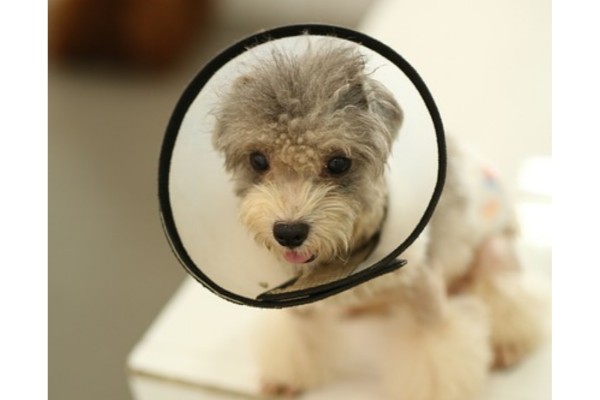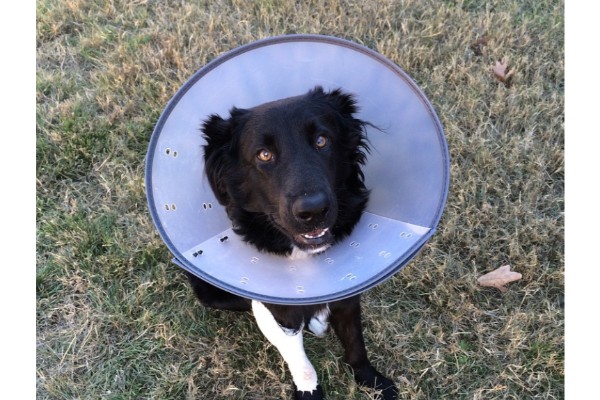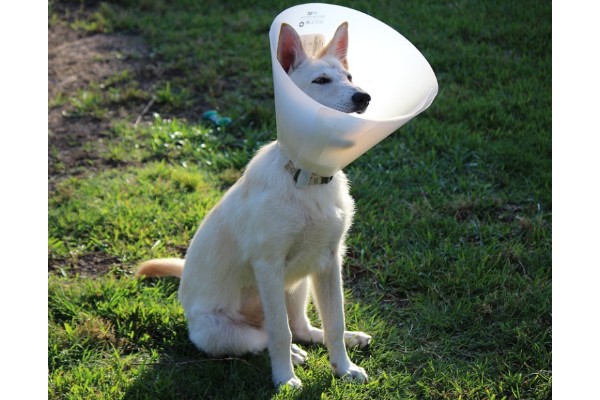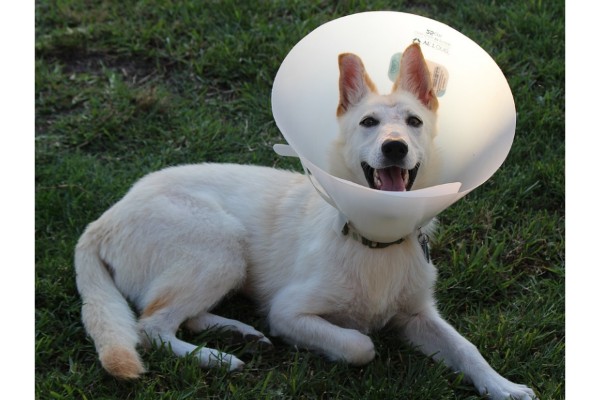Typically, a dog must wear a cone for 10 to 14 days following a spay or neuter procedure; however, it must be worn for much longer (6 to 12 weeks) following orthopedic procedures. After everything has healed, you can usually remove the cone.
Table of Contents
Why Do Dogs Need To Wear Cones?
Dog cones, also referred to as Elizabethan collars or E-collars, serve as a barrier to prevent your dog from licking or scratching a wound, itchy skin, topical medication, or other injuries. Even well-behaved dogs frequently lick and scratch their wounds. The cone must be worn for the duration of your dog’s recovery due to this.
The Benefits Of Wearing A Cone
Cones are a protective measure that stops your dog from interfering with the healing of an incision site, which may include stitches and is frequently associated with neutering or spaying surgical procedures. A collar or cone is necessary to act as a barrier and keep the exposed area safe because it’s natural for pets to lick or bite the injured area. There are several important factors to consider when using a cone for your dog following neuter surgery:
- It keeps the wounded area or incision site clear and helps the healing process
- Recovery is faster
- This barrier can prevent your pet from accidentally hurting the vulnerable area or tearing an incision or stitches
- The cone will allow the incision to heal quickly and prevent additional injuries, leading to costly treatments and surgery
Dog Cone-wearing Risks
The majority of dogs don’t enjoy wearing cones. Additionally, it comes with risks. In a study conducted by The University of Sydney, researchers found that:
1. 60% of pets had difficulty drinking
2. 68% couldn’t play
3. 25% experienced collar-related injuries, including itching/irritation, bumping into walls, falling downstairs, and psychological distress
4. 10% had other issues, including difficulty going to the bathroom, grooming, being fitted for a harness or leash, getting through a dog door, sleeping in a crate, and navigating indoors.
A survey reported that 77.4% of pets had poorer quality of life while wearing the cone. Effects in a variety of welfare domains, such as nutrition, environment, health, behavior, and mental state, were used to determine the quality of life. The study also found that wearing Elizabethan collars could raise stress levels, which could lead to rubbed or ulcerated skin around the neck and aggressive interactions with other animals.1
Dog cones generally result in a narrower field of view and obstruct peripheral vision and hearing. Dogs might find it unsettling and frightening.
Inadequate monitoring and wearing can cause harm to animals, including possible asphyxiation and death. It can also increase costs for pet owners and expose veterinarians to liability.
In addition, dogs who chew, scratch, or bite at their collars run the risk of hurting themselves.

How Long Your Dog Should Wear A Protective Cone
It’s important to allow enough time for your pet’s incision to heal, which can take up to two weeks, whether your dog has sutures that dissolve or traditional stitches that need to be removed by the veterinarian. Even though some surgeries may only take a week or seven days, it’s best to keep your pet’s cone on for two weeks because a partially healed incision can become infected and necessitate additional treatment while also extending the time that they must wear a cone.
It’s best to keep your dog wearing the cone until the sutures have completely disintegrated or your veterinarian removes the stitches if the wound or incision site hasn’t fully healed. You’ll notice less blood loss and quicker recovery if your pet is neutered using laser surgery. The healing time is the same, and the cone should be worn for two weeks, even though laser procedures are preferred because of their accuracy and lower risk of infection.
Monitoring Your Dog While Wearing A Cone
When your dog wears a cone following a neuter surgery, you can expect your pet will need this device for at least one week. Even though this is the bare minimum, your dog’s daily activities, such as feeding, drinking, grooming, and playing, are significantly impacted. A neutered dog must feel safe while donning a cone because it impairs its ability to navigate its familiar surroundings and can feel distressing or frightening.
When your dog leaves the veterinary clinic, there may still be some aftereffects from the general anesthesia used during the neutering procedure. After surgery, your dog might feel worn out, anxious, or scared, and these feelings can take some time to pass. Wearing an Elizabeth collar or cone on your puppy may have psychological effects. It’s important to modify your pet’s food bowls and dog bed during the healing process, which can last up to two weeks or a little longer. You should also cut back on or halt any playtime until your dog is well enough to exercise without the risk of injury.
The First 24 Hours After Neutering
It can be particularly perplexing in the first 24 hours following surgery. not only for you but also for your canine companion. When you take your dog home from the procedure, it’s likely that it will be severely confused. Most veterinarians also administer canines long-term pain relievers to keep animals relaxed and pain-free.
Your dog won’t even look like your dog anymore in terms of behavior! Even the busiest puppy will be groggy and disoriented. They might display depressive symptoms once they start to become more conscious. This should be anticipated and is entirely normal.
Simply allowing your dog to unwind during this period will go a long way toward ensuring their safety. Treat your dog with the same respect you would want to be treated if you had just undergone surgery: don’t expose them to loud noises.
Make a sleeping area that is cozy for them. Make a cozy bed for them to sleep in. It’s important that the space where you keep them is cozy and dimly lit.
Consider locking your dog in a separate room so they can get some rest if you have other animals or curious kids roaming the house.
Do You Need To Pack Them In A Crate?
This solely depends on how behaves your dog. When they first lay down next to you on a bed, dogs occasionally do just fine. Once the effects of the painkillers wear off, though, other people will start to exhibit aggressive behaviors.
You and your dog are both at risk when your dog exhibits aggressive behavior. The hurt and confusion your dog is experiencing could cause them to act out, regardless of how they feel about you or anyone else in the house. Crates might be required in this situation.
Aggression can also cause your dog to inadvertently hurt themselves. After being neutered, dogs are given very delicate stitches. They require a lot of time to recover. Sudden movements could easily break those stitches, which will need to be repaired to prevent infection.
Simply ensure that it is lined with a cozy bed if you do decide to use a crate. Don’t handle it like a prison. Treat it more like a place for healing.
Food, Drink, And Medication
The first day after surgery can be a little challenging for getting your dog to eat or drink. Their appetite may be destroyed by the anesthesia and medication. For the first 24 hours, it’s crucial that you grant access to control over the necessities.
Just half of what you normally provide in terms of food is sufficient. For their first meal, you might want to think about switching to canned food to pique their interest and stimulate their appetite.
Just be sure to ask your veterinarian for the all-clear beforehand.
Try to be as sparing as possible with water. Water intake should be moderate because too much water can make your dog throw up. During the first day or days back at home, it’s crucial to practice patience when it comes to food and water.
Don’t force your dog to eat if it doesn’t want to. The last thing you want to do at this vulnerable time is to upset someone’s stomach.
To aid in recovery, some veterinarians recommend painkillers. Generally speaking, the first 24 hours after administering these medications to your dog should be avoided. Recall that the medications given to them during the procedure may still be in their system.
These medications should be saved for the days after the incision when your dog starts to experience pain there. Continually heed your veterinarian’s instructions.
Can My Dog Walk While It Recovers?

As they heal from the neutering procedure, you can walk your dog for brief distances. To the greatest extent possible, you must restrict their activity. One misstep is all it takes to rip the stitch.
The majority of the time, your dog needs to be contained. If you aren’t home, keep them in a small room or crate so they can’t wander the house and hurt themselves.
Walks should be short and playtime should be light. Keep your dog away from boisterous dogs so he doesn’t become agitated. If your dog jumps up on furniture frequently, keep an eye out for them and put up some barriers to stop them.
Observe Your Dog Regularly
Numerous factors need to be taken into account during the two weeks of recovery. To prevent any problems from arising, you must take an active role in your dog’s care and alter every aspect of its way of life. You should also be keeping an eye on your dog.
Keep an eye on their actions and check the wound twice a day. Teach your dog to roll over and expose his belly. You can then examine the incision site more closely and see if there is any damage as a result.
After neutering a dog, swelling and redness are fairly typical. Watch out for leaking, bleeding, and severe bruising. In the event that issues do arise, you’ll be able to identify them quickly and give your dog the care he requires.
Tips For Making Your Pup Comfortable With A Cone
It’s difficult to adjust to the dreaded cone. When your dog is young, this is especially true. Be prepared to encounter some resistance from your animal companion.
The cone will cause dogs to whine, bark, and even cry in protest. Some talented escape artists will also make every effort to remove the cone on their own.
There are some things you can do to make things easier for them. They won’t completely take away your dog’s discomfort from having the cone on, but they can ease their navigation of the environment.
Guide Your Dog
While wearing the cone does not impair your dog’s ability to see, it does significantly reduce their peripheral vision. Your dog will consequently run into objects, walls, and possibly even people. This lack of vision can be hazardous if you live in a house with stairs.
To ensure their safety while moving around, lead your dog. When you go outside, always wear a leash, and whenever you need to direct them, use your voice.
Teach Them How To Walk Properly
Your dog’s ability to walk will be another problem. Dogs typically walk with their snouts pointed downward. Because of this, every time you walk, the cone strikes the ground.
Your canine companion can be taught to walk proudly. In addition to preventing collisions, this can also slightly widen their field of vision.
Prepare Their Food and Water Bowls for Easy Access
It can be difficult, but it is possible, to eat while wearing a cone. To allow them access, you must strategically place the bowls because the cone frequently extends past the snout. To ensure that the cone can completely encircle the bowls, raise them off the ground by a few inches.
Only Take The Cone Off Sparingly
There are some situations where you might want to remove the cone. This needs to be done sparingly and under close supervision, though.
When eating, many owners decide to remove the cone. With the cone on, it’s not unusual for puppies to refuse food. Consider it a form of nonviolent protest.
Recovery following neutering is an exception to our general advice against encouraging or appeasing that kind of behavior. To allow your dog to eat, you can take the cone off. However, you must always have a direct line of sight and be in the same room.
In order to prevent them from biting or scratching the wound, you should be close enough.
Be Thoughtful
Last but not least, take good care of your dog! With the cone on, does your dog struggle to enter and exit the car or climb the stairs? Make their lives a little bit simpler and raise them up.
Your dog is only going to have these issues for two weeks, so you might as well just take care of any problems they’re having. As a result, there is less stress, more peace, and a better recovery process overall.

FAQs
How Long Will My Dog Feel Pain After Having Been Neutered?
In general, severe discomfort follows surgery for two to three days. That said, a variety of factors can affect how much pain someone experiences. Different dogs manage the discomfort of recovery in different ways.
Dogs, of course, are unable to communicate their emotions to us, so you must pay close attention to how they behave in order to determine how much pain they are experiencing.
Without A Cone, Can I Prevent My Dog From Licking The Stitches?
Dogs have a natural tendency to lick their wounds, so it’s crucial to prevent your pet from getting to the area where the surgery was performed. Try covering the wound with soft fabric or use an alternative to the “cone of shame”
You can experiment with an inflatable collar, a soft E-collar, or a neck brace collar.
Does My Dog Safely Sleep With A Cone On?
With the collar on, your dog shouldn’t have any trouble getting a restful night’s sleep. Early on, it might be difficult. Cones, on the other hand, are made to be as flexible as possible. Your dog can maneuver through the material without difficulty.
They’ll still be able to lie down, walk around, and eat. It’s crucial to wear the cone at night because you won’t be awake to prevent them from messing with the wound.
Conclusion
Your male dog’s future health and happiness can be improved by neutering him. Although the recovery process is never enjoyable, the results are always worthwhile. Your dog will quickly return to normal if you have a little patience, practice careful observation, and have a reliable cone on hand.
